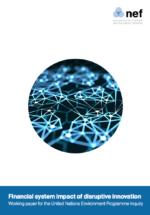Financial system impact of disruptive innovation
Working paper for the United Nations Environment Programme inquiry
20 September 2014
We examine five broad drivers of disruptive change in the financial sector, and their implications for designing a green and inclusive system. The scale of the challenge calls for flexibility and experimentation with a diverse set of policy approaches.
To be truly effective, financial policy and regulation must be forward-looking and prepared to accept the challenge of keeping pace with disruptive innovation – both realised and potential.
Such innovations are by their nature not mainstream, and may never become so. They can be driven by top-down and centralised innovation in policy or by bottom-up and decentralised market innovation.
Five drivers of disruptive innovation
We identify five trends in this report which are relevant to the design of a green and inclusive financial system:
- Disintermediation of capital and payments: The use of technology combined with new business models is removing traditional intermediaries from financial transactions. For example, savers can now connect more directly with borrowers through Peer-to-Peer landing platforms instead of using a bank. New forms of payment systems, including decentralised digital currencies such as Bitcoin, are also challenging the existing banking industry.
- New forms of credit creation: Money is created by banks when they extend credit. Bank deposits are guaranteed by the state, but other forms of IOUs issued by non-banks without state backing can also be accepted as money. This is not new, but digital technology offers new possibilities for decentralised credit creation that can be directed to more social and environmentally beneficial outcomes.
- Long-term environmental and social impacts: A range of related phenomena — from resource constraints and climate change to unsustainable debt levels – has implications for long-term economic trends. These factors are important for long-term savings vehicles ‒ in particular funded pension schemes ‒ and for the insurance industry.
- Technological innovation: The use of information technology has led to a revolution in the way that financial transactions are recorded and processed as well as leading to the provision of new services and business models. Two interlinked and overlapping technological trends ‒ the increase in volume and variety of data (‘big data’), and the move towards everyday devices being connected to networks (the ‘Internet of Things’) ‒ are likely to require some aspects of the financial system to adjust their practices in order to remain relevant and profitable in the future.
- Innovations in economics and financial policy: The financial crisis has led to a re-examination of earlier theories and policy instruments in the field of macroeconomics and finance, with consequences for monetary policy and the regulation of the financial sector. We examine six developments in the area of macroeconomic and financial policy that have potential to contribute to the design of a green and inclusive financial system: capital flow management, green credit guidance, strategic quantitative easing, full reserve banking, financial transactions tax (FTT), and the evolution of a global reserve currency.
Implications for design of a green and inclusive financial system
The aim of this research is not simply to compile a list of innovations or to make predictions. The question is to what extent the drivers of change identified here are relevant for the design of a sustainable financial system. We can break this down into a series of further questions:
- Is the innovation likely to have a material impact?
- If so, will it improve, worsen, or have no impact on the sustainability performance of the financial system?
- Might it interact with other innovations in ways that enhance its impact?
- What should the policy response be, if any?
We assessed the applicability of existing regulatory structures to the different innovation domains discussed above and mapped this against their likely scale and potential to drive systemic change. Using these three criteria we derived three different clusters:
- High potential for systemic change ‒ existing regulatory structures are applicable.
- Low potential for systemic change ‒ existing regulatory structures are applicable.
- High potential for systemic change ‒ existing regulatory structures have little applicability.
We recommend that policymakers should focus their attention on the third cluster where the potential impact is high, but existing regulation is weak. But further regulation is not the inevitable outcome.
One common feature of these innovations is placing more market power in the hands of consumers, for example by allowing them to choose directly which projects and companies to invest in. This poses an intriguing question: Will the collective decisions of empowered individuals lead to greener and more inclusive outcomes than the collective decisions of today’s financial market professionals?
If we think they will, then we could be in the ideal position of regulation being redundant. If we are not sure, however, we need to consider what instruments can encourage more sustainable outcomes within a much more decentralised financial system.
The primary conclusion we draw for the UNEP Inquiry is that financial policy and regulation can be divided into two types:
- first, those where co-ordinated global action is required, and
- secondly those where a variety of different national or regional approaches is both possible and desirable.
Given the uncertainties facing the global economy and the scale of the challenge of transitioning to a green and inclusive financial system, experimentation with a diverse set of policy approaches would encourage innovation and speed of development.
This research was conducted in support of the United Nations Environment Programme (UNEP) Inquiry into the design of a sustainable financial system that can accelerate the transition to a prosperous and inclusive green economy.
Topics Banking & finance







